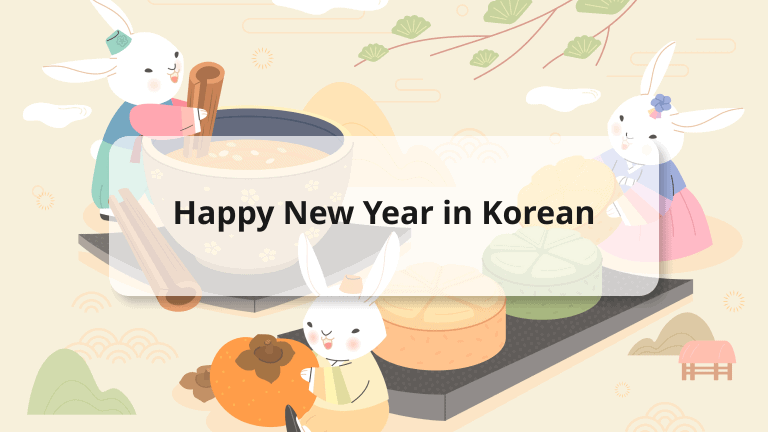Are you excited to ring in the New Year? In Korea, the celebration of the New Year is filled with rich traditions and cultural customs. In this article, we’ll teach you how to say “Happy New Year” in Korean, so you can join in on the fun. You’ll also learn about the special traditions and celebrations that take place in Korea during the holiday season.
The Korean New Year: Solar and Lunar

The Korean New Year, or “Seollal,” is a holiday that celebrates the beginning of the new year according to the lunar calendar. It typically falls in January or February and is a time for families to come together and participate in traditional activities and rituals. In addition to Seollal, Korea also celebrates the New Year according to the solar calendar, which is known as “Gaan-nyeok.” This holiday takes place on January 1st and is similar to New Year’s Day celebrations in other countries.
The lunar calendar is based on the cycles of the moon, and each year is represented by one of 12 animals in the zodiac. The Korean New Year, or “Seollal,” is a three-day holiday that marks the beginning of the new year according to the lunar calendar. It is a time for families to come together and participate in traditional activities and rituals, such as ancestral rites, folk games, and special meals.
One of the most important customs during Seollal is the ritual of “charye,” in which families pay respect to their ancestors by offering food and other gifts. Seollal is also a time for forgiveness and the settling of any grudges or disputes within the family.
In addition to Seollal, Korea also celebrates the New Year according to the solar calendar, which is known as “Gaan-nyeok.” This holiday takes place on January 1st and is similar to New Year’s Day celebrations in other countries. Gaan-nyeok is a public holiday in Korea, and many people use the occasion to go on vacation or participate in festive events and parties.
Both Seollal and Gaan-nyeok are important holidays in Korea and offer a chance for families and communities to come together and celebrate the start of the new year. Whether you’re celebrating Seollal or Gaan-nyeok, learning about the traditions and customs of the Korean New Year is a great way to experience and appreciate the country’s rich culture and history.
Greetings for the Korean New Year

If you’re planning to celebrate Seollal or Gaan-nyeok in Korea, it’s important to know how to say “Happy New Year” in Korean. Here are a few different ways to greet someone during the holiday season:
- Formal: “Seh-hahm-nee-dah” (새해 복 많이 받으세요)
- Informal: “Seh-hahm-mah-nee” (새해 맞이 축하합니다)
- Standard: “Seh-hahm-muh-sae” (새해 복 많이 받으세요)
It’s also common to exchange bows as a sign of respect during the Korean New Year. If you’re greeting an elder or someone in a position of authority, it’s proper etiquette to bow slightly lower than them.
In Korean, the phrase for “Happy New Year” is “Seh-hahm-muh-sae” (새해 복 많이 받으세요). This phrase can be used in both formal and standard settings, and is a common greeting during the holiday season.
In addition to the standard phrase for “Happy New Year,” there are also more formal and informal ways to greet someone during the holiday season in Korea. Here are a few examples:
- Formal: “Seh-hahm-nee-dah” (새해 복 많이 받으세요)
- Informal: “Seh-hahm-mah-nee” (새해 맞이 축하합니다)
It’s also common to exchange bows as a sign of respect during the Korean New Year. If you’re greeting an elder or someone in a position of authority, it’s proper etiquette to bow slightly lower than them.
The Korean New Year, or “Seollal,” is a time for families to come together and celebrate the beginning of the new year according to the lunar calendar. In Korean culture, the New Year is a time for renewal and a chance to start fresh. It is a time for forgiveness and the settling of any grudges or disputes within the family. The holiday is also an opportunity to pay respect to one’s ancestors and honor their memory.
During Seollal, it is traditional to wear hanboks, which are traditional Korean clothing. Children also receive sebaetdon, which are small gifts of money from their elders. Seollal is also a time for folk games and special meals, such as tteokguk (a rice cake soup) and ddeokguk (a rice cake soup with dumplings).
Learning how to say “Happy New Year” in Korean is a great way to join in on the holiday celebrations and show your respect for Korean culture and traditions. Whether you’re planning a trip to Korea or just want to learn more about the country’s rich culture, understanding the customs and greetings of the Korean New Year is a valuable way to experience and appreciate the unique culture of Korea.
New Year’s Resolutions in Korean

Making New Year’s resolutions is a common tradition in many cultures, and Korea is no exception. Here is an example conversation in Korean about making resolutions for the new year:
Person 1: “Nae-il-ah nae-il-lyeo-hahn-juhng hae-juh-sae-yo?” (내일 새해로 한정 해주세요?)
Person 2: “Ne, nae-il-ah nae-il-lyeo-hahn-juhng hae-juh-sae-yo.” (예, 내일 새해로 한정 해주세요.)
Person 1: “Nae-il-ah nae-il-lyeo-hahn-juhng, saeng-gak hae-juh-sae-yo.” (내일 새해로 한정, 생각 해주세요.)
Person 2: “Ne, saeng-gak hae-juh-sae-yo.” (예, 생각 해주세요.)
In this conversation, Person 1 is asking Person 2 to make a New Year’s resolution. Person 2 agrees and then asks Person 1 to do the same.
In Korean, “nae-il” (내일) means “tomorrow,” “lyeo-hahn-juhng” (한정) means “resolution,” and “sae-yo” (세요) is a formal way to request something. So in this conversation, Person 1 is asking Person 2 to make a New Year’s resolution. Person 2 agrees and then asks Person 1 to do the same.
Some common New Year’s resolutions in Korean might include:
- “Jook-soo hap-sae-yo” (죽수합시요) – “I will quit smoking.”
- “Sul-guk hap-sae-yo” (술국합시요) – “I will stop drinking.”
- “Sul-myeo hap-sae-yo” (술며합시요) – “I will drink less.”
- “Gong-boo hap-sae-yo” (공부합시요) – “I will study more.”
- “Ee-seu hap-sae-yo” (이슈합시요) – “I will exercise more.”
It’s also common for people to make resolutions related to their personal or professional goals, such as finding a new job, learning a new skill, or saving money.
Making New Year’s resolutions is a great way to set goals and motivate oneself to make positive changes in the new year. Whether you’re celebrating Seollal or Gaan-nyeok, or just looking for ways to improve yourself and your life, taking the time to reflect on your resolutions can be a meaningful and rewarding experience. So, if you’re planning to celebrate the Korean New Year, consider making a resolution and joining in on this important cultural tradition.
Ending the Korean New Year Celebration on a High Note
As you can see, the celebration of the New Year in Korea is filled with unique traditions and cultural customs. Whether you’re planning a trip to Korea or just want to learn about the holiday season in the country, learning how to say “Happy New Year” in Korean is a great place to start. We hope you enjoyed learning about the Korean New Year and that you have a happy and healthy start to the new year! If you’re interested in learning more about Korean culture and language, check out AmazingTalker for high-quality language learning resources and classes.
Discover the answers to your language-related questions on AmazingTalker’s Q&A page.
















